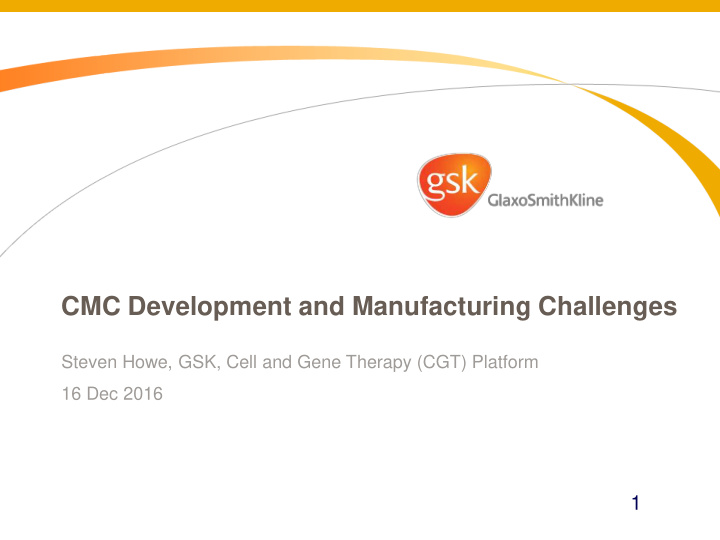



CMC Development and Manufacturing Challenges Steven Howe, GSK, Cell and Gene Therapy (CGT) Platform 16 Dec 2016 1
Summary of CGT technologies – GSK View Delivery vehicle Ex vivo, autologous (e.g. lentivirus, AAV) CGT product Transduction Cell Transfection Vector Donor Ex vivo, allogeneic Cell CGT product Transduction In vivo GT product • ATMPs broader than Gene Therapy. GSK focus has been on Gene Therapy hence the focus of this talk • Comments, differing points of view on other ATMPs welcome 2
Partnerships to accelerate growth and build expertise GSK’s investm ent in ex vivo autologous cell platform Development and manufacturing TIGET Ex Vivo Autologous CGT Pipeline collaborations Respiratory Rare Neuroscience ADD MPC Diseases Diseases ADA-SCID MLD WAS Infectious Oncology Dermatology Immuno- Diseases inflammation NYESO1 Internal GSK Pipeline 3
Promise and Challenge of CGT Medicines Pipeline Patient numbers 100,000 10,000 1000 100 10 MLD & WAS Oncology ADA-SCID “Strimvelis” 4
Ex-Vivo Autologous Therapy Development and Manufacturing Challenges Vector Scale-Up - Capacity, Quality, Robustness – Current challenge and some suggested future approaches Ex-Vivo Cell Processing – Scale out – 1 patient = 1 batch – Scale out challenge and proposed future vision Change Management – Approach to Comparability – Rational approach to comparability Analytical- Modernization of analytical tools Supply chain – Logistics and Supply Chain 5
Vector Manufacturing Adherent cell factory processes Operation usually in <100L volumes 1 batch can meet the drug product needs for 1 to 10 patients (typically) 6
Vector Scale Up – Proposed approach Fully disposable scalable platform Move from adherent culture to suspension Move from transient transfection to stable cell line production Eliminates the need for ongoing plasmid manufacture Important challenges to address, stability of cell line, titer, “true platform” Has the potential to transform current processes to meet demands such that 100s and 1000s of doses per batch 7
Cell Process Scale out Current process manual, very often involve open manipulations by highly skilled operators Scale out needs significant as patient populations particularly in Oncology could be large QP Release 8
Manufacturing Models Centralized – Single facility, cells in (Fresh/frozen), drug product out (typically frozen) – Controlled operations, minimize product variation, maximize expertise – Challenges: practicality for large indications, availability of trained operators, logistical challenges De-centralized – Regional Hubs – True scale out, reduces logistical challenges, better patient access – Tech transfer needed, both process and analytics – Raw Materials, consumables supply chain 9
Cell Process Scale out – Future Direction Bespoke, manual process Multiple Automated units in a Fully automated system ballroom suite in regional hubs Current Regional Cell Processing with integrated QC testing Hubs ‘Ballroom’ Suites in Regional Hubs with Exact Copy Automation Challenges Cell Processing “In Hospital Solution” Technical GMP/Regulatory Fully closed, automated process QA, QP Release Local? In-line, in –process analytics Manufacturing within hospital Continuous process validation Robust tracking Raw Material sourcing/supply Troubleshooting, deviation management, QMS Process and product drift over time 10
Change Management and Comparability Rapid pace of innovation in tools for manufacturing and testing Continuous and logical application of these tools will involve management of change and proving comparability Approach to comparability that GSK has followed is based on Risk Assessments and general framework provided by ICH Q5E Examples based on expected changes in manufacturing 11
Proposed Changes – An Approach to Address Comparability Manufacturing Process Proposed Process Rationale for Process v 1.0 Component v 2.0 Change Vector Process Cell expansion Adherent Suspension • Enable treatment Case 1 of larger population of Cell Manual Implementation of patients including manipulation production automation some older Cell Process patients Case 2 Fresh product • Improve supply Final product Cryopreserved chain robustness with 4 hour shelf formulation product. life 12
Assess Impact of Vector Process Change Potential Potential Vector CQAs Cell Product CQAs Impact Impact Infectious viral titer H Percent CD34+ L Infectivity H Vector copy number H CD34+ Stem Cell Potential L Transgene sequence L Vector Integrity L Enzyme Activity H HCP H Cell Viability (%) L HC DNA H Transduction efficiency H Benzonase L Endotoxin L Microbiological Control L Mycoplasma L mycoplasma L Microbiological Control L endotoxin L RCL L Adventitious virus L Adventitious virus L Plasmid DNA M HCP H RCL L Plasmid DNA M Capture Host Cell DNA H rationale for Residual cytokines L outputs to be 13 studied
Comparability Study Design Process 1 Process 2 3 full scale vector batches 3 full scale vector batches V S Stability Testing Stability Testing Vector characterisation based on impact assessment 3 Vector batches 3 Vector batches (Study 1) (Study 1) Transduction Transduction V 3 lots of HD apheresis 3 lots of HD apheresis S Stability Testing Stability Testing C ell characterisation based on impact assessment 14
Discussion Points 1. The need for in vivo comparability studies 2. Will cell product comparability always be required to support vector process changes? 3. How should in vitro comparability studies be designed when considering manufacturing site changes (e.g. sites in Europe and US)? a) Split apheresis between two sites (logistical risks) b) How to set acceptance criteria despite inherent variability of starting material? Use (sometimes limited) clinical and development data? 4. What are comparability implications for a true decentralized or in-hospital solution? 5. Need for analytical method comparability (bridging studies) when assays are changed 15
Summary ATMPs have the potential to be transformative medicines Current manufacturing paradigms will need substantial innovation in all aspects – Technical, Regulatory, Quality, to supply global demand for these medicines Close collaboration between industry, academia, and regulatory agencies needed to bring these transformational medicines to a wider patient population 16
Recommend
More recommend